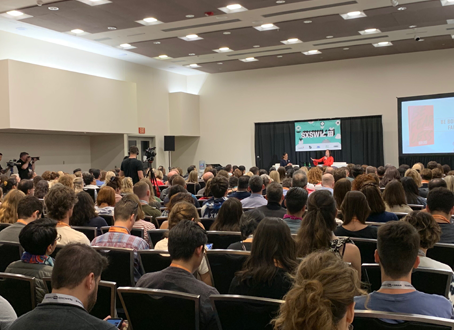At SXSW 2016, the Case Foundation took the stage to engage in an important conversation on inclusive entrepreneurship. The goal was to talk openly about and spark ideas around how to level the playing field for all entrepreneurs in order to create stronger communities, close the opportunity gap and scale creative solutions to persistent problems. We had 60 minutes, an audience that wanted to be engaged (not talked at) and a serious, sometimes sensitive topic. No big deal, right?
Embracing our “be bold, take risks” attitude, we tried a somewhat unorthodox route. Inspired by NPR’s popular “Wait, Wait…Don’t Tell Me!” show, we crafted a series of stories to share with the audience, who then had to decide whether each one was true or false. Each story was specially crafted to confront a myth of entrepreneurship—stories that pervade our culture, our media and our minds—head on. These are stories that we felt were important to flag because they may have the unintended consequence of keeping entrepreneurs from tackling some of the world’s greatest challenges and may be particularly holding back women entrepreneurs and entrepreneurs of color. The stories were told by some of the sector’s most inspirational changemakers, while Jean Case and I did our best impersonations of Peter Sagal and Bill Kurtis, the stewards of the real show. Check it out here and play for yourself!
![story1SXSW[InHand]](https://casefoundation.org//wp-content/uploads/2016/04/story1SXSWInHand.jpg)
Not far from the slot machines and neon lights of the Las Vegas Strip, a few dozen tech companies hammer away at the future. That’s where you’ll find young African American Frederick Hutson, CEO of Pigeon.ly, a company that helps prison inmates stay connected to family by providing them with simple ways to receive hard-copy photographs and place inexpensive long-distance phone calls. Its secret sauce is a proprietary 50-state prisoner database that makes locating inmates as easy as typing their names in a search box. Hutson knows this problem first hand—he did 51 months in jail after being busted for marijuana distribution, his last “successful” venture. He put the same skills that made him a good drug dealer—high tolerance for risk and a desire to solve problems creatively—to use in starting this legitimate, innovative company. Pigeon.ly has successfully scaled from the $1 million in seed funding it originally received from top Silicon Valley players.
So what do you think? Is this story true or false? Did this former inmate have a million dollar idea? The majority of our audience thought it was true… and they were right! But there was much to this story that should have given the audience pause. Frederick’s profile certainly doesn’t fit the image or the data of who is an entrepreneur—the latest U.S. Census data shows that 79 percent of entrepreneurs in the U.S. are white and recent analysis shows that only 1 percent of venture capital funded startups have African American founders. Nor is the market Frederick disrupted an obvious one. Which is why this story is so important—it busts the myth that only well-connected, well-resourced white guys can succeed in the startup world, and it also demonstrates the existence of niche markets with great potential for investment that often go untapped. At his very core, Frederick is an entrepreneur, a problem solver, who re-applied his entrepreneurial talents from an illicit community business to a legitimate, job-creating, community-strengthening venture. It makes us think hard about the potential to drive social change by creating more onramps for diverse entrepreneurs.
![story2SXSW[2]](https://casefoundation.org//wp-content/uploads/2016/04/story2SXSW2.jpg)
In 1867, Clifford Jackson was born to Elsie and Thomas Pinkton. Elsie worked in the local salon and Thomas was a baker. They were your average white, middle class family and lived a good life in St. Louis. Young Cliff would go to the salon that his mother worked in after school and saw many women coming in and requesting help with hair loss issues—he knew there had to be a better solution than a scalp massage and a butter-based application. So Cliff did his research, toiled away in his parents’ garage and, voila, concocted his own solution. His initial investment was $1.25. The free samples flew off of the shelves at the salon where his mother worked, and soon, with more orders than he could fill himself, he started a business focused on selling “CJ’s Wonderful Hair Grower.” The picture of his smiling face, thick blond hair and pale white skin was the picture of health and happiness. Customers were hooked! The product was particularly popular with the black women in his town, and they appreciated his research and in-depth knowledge of the hair styling challenges they faced on a daily basis. The organic success of this product drew white investors in particular to this untapped market. Cliff went on to corner the black hair care product market in the U.S. and became a billionaire by the age of 57.
What do you think? Is this story true or false? Could Cliff, a young white man, corner the black women’s hair care market? Well, Kesha’s animated delivery of the story fooled our audience, despite what we all know grounds successful ventures—personal knowledge of the problem you are trying to solve and persistence (the “Eureka moment” really is myth!) in proving the profitability of untapped markets! The actual inspiration for Kesha’s story was the real life success of hair tycoon Madam CJ Walker, whose deep knowledge of the market and true grit aided her in building a client-base for her product and led her down the path of becoming the first black American female self-made millionaire. So why did our audience, and maybe you, find the Cliff story so easy to believe? Maybe it’s because Cliff’s demographic remains the dominant profile of an entrepreneur. Maybe it’s because the link between personal experience and the problem being solved still does not prevail in today’s narrative of successful entrepreneurs. Sadly, almost 150 years later, the uniqueness of Madame CJ Walker’s success as a startup founder remains true today—a recent study cites only 11 black female founders have raised more than $1 million; only 9.7 percent of venture-backed companies have female founders; and less than 1 percent have an African-American founder. Against the backdrop of data showing women-founded ventures outperforming their male counterparts and companies with diverse (gender and race) leadership teams provide greater returns for investors (McKinsey and Harvard Business Review), this story helps shape a conversation around why.
![story3SXSW[2]](https://casefoundation.org//wp-content/uploads/2016/04/story3SXSW2.jpg)
There is plenty of debate over whether entrepreneurs are born or made. Two prominent and opinionated researchers duke it out. Koch, president emeritus at Old Dominion University and co-author of the 2008 book Born, Not Made: The Entrepreneurial Personality, argues that many entrepreneurs are simply wired that way, giving them a natural advantage in the business world. Julian Lange of Babson College, on the other hand, says her research in the past five years indicates that exposure to the ideas and lessons of entrepreneurship can have lasting effects on students, even if they are not “natural” entrepreneurs.
Forbes 10 Under 10 competition settles the debate—entrepreneurs are born! Who can argue with 9 and 10-year olds Tracy and Jackie Tsang, whose award-winning app Binky Meets Cradle is solving one of the world’s most pressing problems—boring playdates? Or with 10-year-old Ryan Pohlson’s company, Duck Duck Duck, which is disrupting the bath time industry with rubber ducks and big data? Says Pohlson, “It’s like Uber but for Ducks.” And fan favorite, Aaron Rogier, who at five conceived of Napchat, a wildly popular app for kids to behave for their parents while also innovating on the nap concept, making it, you know, like “mobile-y and socially.” When asked what advice they’d give their younger selves, the under 10-year-olds said, “they wished they’d dropped out of school sooner and bought more bitcoins.” After all, “It’s tough to stay relevant in the Valley past a certain age,” one kid remarked.
When it comes to Forbes 10 under 10, what do you think? Is this story true or false? Our audience had a harder time deciding and the vote was fairly divided. The correct answer was false, built around both a very funny video and the very real academic debate between Koch and Lange (and many others) on whether entrepreneurs are born or nurtured. I suspect the divided vote is emblematic of two things: (1) the continued impression that startups are purely a young person’s game, with particular glorification around college dropouts making it big—Bill Gates, Rachael Ray, Mark Zuckerberg, Steve Jobs, Mary Kay Ash, Jack Dorsey; and, (2) an honest debate with little data to prove whether entrepreneurs are born that way, or whether many have the innate potential to create and drive businesses, but without nurturing of that potential they move on to other things.
This story helped us and the audience confront the role myths might be playing in leaving teams of entrepreneurs on the sidelines—particularly women and entrepreneurs of color. For example, the actual average age of today’s startup founders is 40. If people knew that, would they drop out of school so fast? Or what if we had entrepreneurial talent scouts like we do for sports and music—would that make a difference? (Check out Gallup’s entrepreneurial talent finder.) And is there an important role for startups dedicated exclusively to women or entrepreneurs of color to help level the playing field? Regardless of where you sit in this debate, there seems to be a widely shared support for exposing youth early to entrepreneurship as a life and career path, as well as encouraging mainstream media to showcase more diverse entrepreneurs as role models. Regardless of nature or nurture, the quote, “you can’t be what you can’t see” captured the audience.
![story4SXSW[3]](https://casefoundation.org//wp-content/uploads/2016/04/story4SXSW3.jpg)
Picture this! It’s a beautiful sunny day in Palo Alto in April 2012. I am over the moon excited to pitch my new idea—CODE2040. I am bouncing on my toes to diffuse my nerves as I wait for my turn to try to win $80,000 in support for my work. I knew CODE2040 was a great idea and I knew that if we could execute well, it was going to change people, communities and industries for the better. I mean, there was such an obvious market for our business—addressing the problem of inequality of opportunity for talented entrepreneurs who don’t have access to the social networks, and family and friends startup capital, that other entrepreneurs can tap into. The judges would obviously understand this, and see past the fact that we only had two months of operations under our belts. No impact data. All I needed to do was convince them that our idea was a great idea! I got this! My materials are great! I walk on stage. I look at those judges standing between me and the $80,000 that is going to launch CODE2040.
And, I choke. I can’t find my words. I fumble through the material, reading half of it off my slide notes. When it was time for Q&A, I was shaking with nerves, and when one of the judges, a white male professor with no knowledge of my market or the community we hoped to serve, became increasingly belligerent, insisting that the concept had no legs and we were seeing problems where there were none, I was stunned to speechlessness. I failed. I did not walk away with the $80,000 prize. And that day, the best pitch did indeed win, but it was not the best idea of all those pitched. As crushed as I was to lose in 2012, I knew that this would be the first of many defeats and no’s, and that I needed to use the experience to fail forward, learn from my mistakes, and go back the next year with a pitch that took into account the skeptics. One year later, picture this! A beautiful sunny day in Palo Alto and I am bouncing on my toes again outside the very same room. I pitch. I answer questions. And I win! And that early money paved the way for me to go on to raise about $10M in support for CODE2040 to date.
Was Laura’s pitch the real deal or was her story made up? If you thought her story was true, you were right! Thankfully, Laura did win that second pitch and CODE2040 exists today. The reality of Laura’s story though shows how pitch competitions can be flawed. Often times the best idea is not the winning idea and vice versa. For women in particular, the pitch competition model can be extremely disadvantageous. While certainly not the case for all women, studies have shown that women tend to be less willing to assume risks that may accompany failure (Koellinger et al., 2008; Minniti, 2010). Could a pitch competition be that detrimental to a business? It can be when the reality is that women are twice as likely as men to shut down their businesses because of lack of capital—capital that may be coming from a singular source, pitch competitions. As if the cards weren’t stacked against women enough, a recent study showed that attractive men are most likely to win pitch competitions (even when the same pitch is delivered by a woman)!
So how did you do?
Could you tell fact from fiction? More importantly, did reading these stories help you better understand the challenges women entrepreneurs and entrepreneurs of color face in the startup world and why it’s vitally important that we work together to create change? We challenged the audience at SXSW and now challenge you, our readers, to help usher in meaningful change through your own channels—change that involves building stronger entrepreneurial ecosystems, unlocking venture capital funding opportunities, helping address policy issues and disrupting the dominant narratives about entrepreneurship so that the stories reflect more diversity.
Want to read more myths? Check out our ongoing blog series.
Do you have your own true/false story that you want to share with us? Tweet your headline to us @CaseFoundation using the hashtag #Ent4All and we might profile your story next!



![story1SXSW[InHand]](https://casefoundation.org//wp-content/uploads/2016/04/story1SXSWInHand.jpg)
![story2SXSW[2]](https://casefoundation.org//wp-content/uploads/2016/04/story2SXSW2.jpg)
![story3SXSW[2]](https://casefoundation.org//wp-content/uploads/2016/04/story3SXSW2.jpg)
![story4SXSW[3]](https://casefoundation.org//wp-content/uploads/2016/04/story4SXSW3.jpg)


